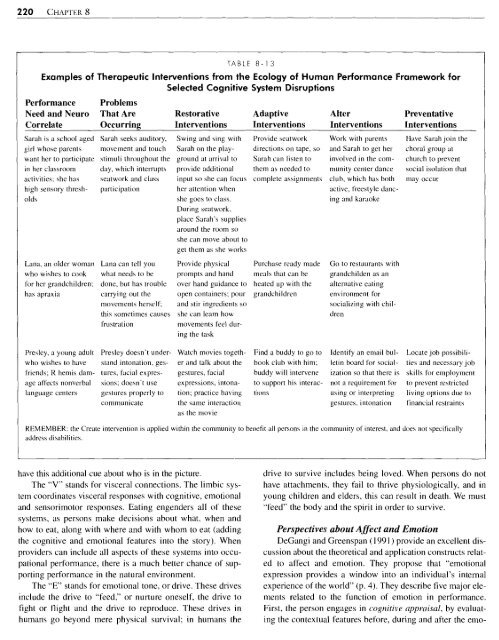Implementing Neuroscience Principles to Support Habilitation and ...
Implementing Neuroscience Principles to Support Habilitation and ...
Implementing Neuroscience Principles to Support Habilitation and ...
Create successful ePaper yourself
Turn your PDF publications into a flip-book with our unique Google optimized e-Paper software.
TABLE 8-1 3<br />
Examples of Therapeutic Interventions from the Ecology of Human Performance Framework for<br />
Selected Cognitive System Disruptions<br />
Performance Problems<br />
Need <strong>and</strong> Neuro That Are Res<strong>to</strong>rative Adaptive Alter Preventative<br />
Correlate Occurring Interventions Interventions Interventions Interventions<br />
Sarah is a school aged Sarah seeks audi<strong>to</strong>ry,<br />
girl whose parents movement <strong>and</strong> <strong>to</strong>uch<br />
want her <strong>to</strong> participate stimuli throughout the<br />
in her classroom day, which interrupts<br />
activities: she has seatwork <strong>and</strong> class<br />
high sensory thresh- participation<br />
old5<br />
Lana, an older woman Lana can tell you<br />
who wishes <strong>to</strong> cook what needs <strong>to</strong> be<br />
for her gr<strong>and</strong>children; done, but has trouble<br />
has apraxia<br />
carrying out the<br />
movements herself;<br />
this sometimes causes<br />
frustration<br />
Swing <strong>and</strong> sing with<br />
Sarah on the playground<br />
at arrival <strong>to</strong><br />
provide additional<br />
input so she can focus<br />
her attention when<br />
she goes <strong>to</strong> class.<br />
During seatwork,<br />
place Sarah's supplies<br />
around the room so<br />
she can move about <strong>to</strong><br />
get them as she works<br />
Provide physical<br />
prompts <strong>and</strong> h<strong>and</strong><br />
over h<strong>and</strong> guidance <strong>to</strong><br />
open containers; pour<br />
<strong>and</strong> stir ingredients so<br />
she can learn how<br />
movements feel during<br />
the task<br />
Provide seatwork<br />
directions on tape, so<br />
Sarah can listen <strong>to</strong><br />
them as needed <strong>to</strong><br />
complete assignmenls<br />
Purchase ready made<br />
meals that can be<br />
heated up with the<br />
gr<strong>and</strong>children<br />
Work with parents<br />
<strong>and</strong> Sarah <strong>to</strong> get her<br />
involved in the community<br />
center dance<br />
club, which has both<br />
active, freestyle dancing<br />
<strong>and</strong> karaoke<br />
Go <strong>to</strong> restaurants with<br />
gr<strong>and</strong>childen as an<br />
alternative eating<br />
environment for<br />
socializing with children<br />
Have Sarah join the<br />
choral group at<br />
church <strong>to</strong> prevent<br />
social isolation that<br />
may occur<br />
Presley, a young adult Presley doesn't underwho<br />
wishes <strong>to</strong> have st<strong>and</strong> in<strong>to</strong>nation, gesfriends;<br />
R hemis dam- tures, facial expresage<br />
affects nonverbal sions; doesn't use<br />
language centers gestures properly <strong>to</strong><br />
communicate<br />
Watch movies <strong>to</strong>gether<br />
<strong>and</strong> talk about the<br />
gestures, facial<br />
expressions, in<strong>to</strong>nntion;<br />
practice having<br />
the same interaction<br />
as the movie<br />
Find a buddy <strong>to</strong> go <strong>to</strong><br />
book club with him;<br />
buddy will intervene<br />
<strong>to</strong> support his interactions<br />
Identify an email bulletin<br />
board for socialization<br />
so that there is<br />
not a requirement for<br />
using or interpreting<br />
gestures. in<strong>to</strong>natinn<br />
Locate job possibilities<br />
<strong>and</strong> necessary job<br />
skills for employment<br />
<strong>to</strong> prevent restricted<br />
living options due <strong>to</strong><br />
financial restraints<br />
REMEMBER: the Create intervention is applied within the community <strong>to</strong> benefit all pcrsons in the community of interest, <strong>and</strong> does not specifically<br />
address disabilities.<br />
have this additional cue about who is in the picture.<br />
The "V" st<strong>and</strong>s for visceral connections. The limbic system<br />
coordinates visceral responses with cognitive, emotional<br />
<strong>and</strong> sensorimo<strong>to</strong>r responses. Eating engenders all of these<br />
systems, as persons make decisions about what. when <strong>and</strong><br />
how <strong>to</strong> eat, along with where <strong>and</strong> with whom <strong>to</strong> eat (adding<br />
the cognitive <strong>and</strong> emotional features in<strong>to</strong> the s<strong>to</strong>ry). When<br />
providers can include all acpects of these systems in<strong>to</strong> occupational<br />
performance, there is a much better chance of supporting<br />
performance in the natural environment.<br />
The "E st<strong>and</strong>s for emotional <strong>to</strong>ne, or drive. These drives<br />
include the drive <strong>to</strong> "feed." or nurture oneself, the drive <strong>to</strong><br />
fight or flight <strong>and</strong> the drive <strong>to</strong> reproduce. These drives in<br />
human4 go beyond mere physical survival; in humans the<br />
drive <strong>to</strong> survive includes being loved. When persons do not<br />
have attachments. they fail <strong>to</strong> thrive physiologically, <strong>and</strong> in<br />
young children <strong>and</strong> elders, this can result in death. We must<br />
"feed" the body <strong>and</strong> the cpirit in order <strong>to</strong> survive.<br />
Perspectives about Affect <strong>and</strong> Emotion<br />
DeGangi <strong>and</strong> Greenspan ( 199 1 ) provide an excellent discussion<br />
about the theoretical <strong>and</strong> application constructs related<br />
<strong>to</strong> affect <strong>and</strong> emotion. They propose that "emotional<br />
expression provides a window in<strong>to</strong> an individual's internal<br />
experience of the world" (p. 4). They describe five major elements<br />
related <strong>to</strong> the function of emotion in performance.<br />
First, the person engages in cognitive c~pprrrisal, by evaluating<br />
the contextual features before, during <strong>and</strong> after the emo-





